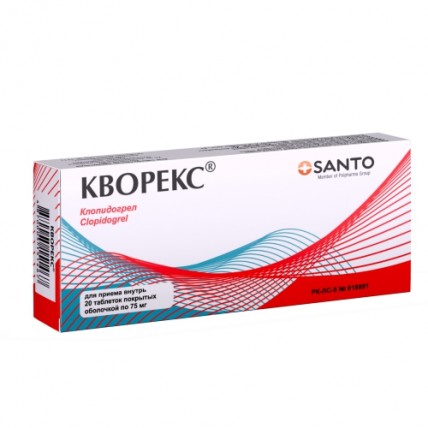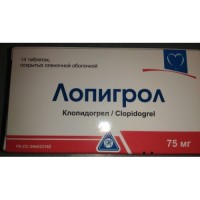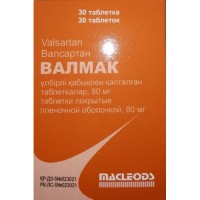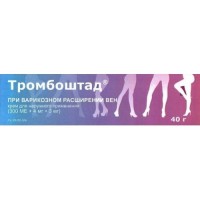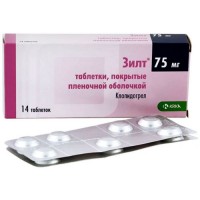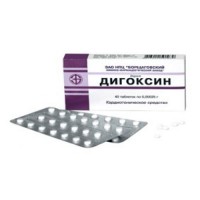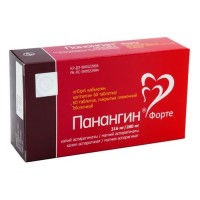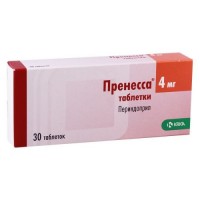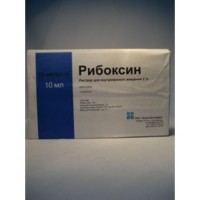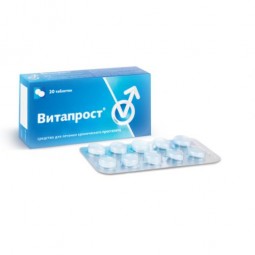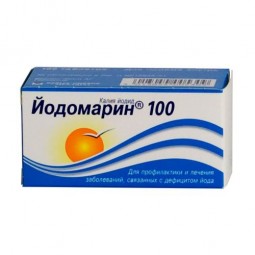Kvoreks 20s 75 mg coated tablets
- $48.30
Trade name
of Kvorex
the International unlicensed
name Klopidogrel Lekarstvennaya
the Tablet form, coated, 75 mg
Structure
One tablet contains
active agent - klopidogrelya bisulphate
(in terms of klopidogret) 75.0 mg,
excipients: microcrystalline cellulose, lactoses monohydrate, kopovidon (Kollidon VA 64), krospovidon XL-10, talc, silicon dioxide colloidal (aerosil), magnesium stearate,
structure of a cover: gipromelloz (hydroksipropilmetiltsellyuloz), titan dioxide (E 171), triacetin, liquid paraffin.
Description
of the Tablet, coated, biconvex, color, white or white with a creamy shade.
Pharmacotherapeutic group
Anticoagulants. Inhibitors of aggregation of thrombocytes.
The code of automatic telephone exchange B01AC04
Reception single and repeated oral doses on 75 mg a day klopidogret the pharmacological Pharmacokinetics At properties quickly is soaked up. Average maximum plasma concentration not changed klopidogrelya (about 2.2-2.5 ng/ml after one 75 mg of an oral dose) were noted in 45 minutes after dosing.
Klopidogrel and his main circulating metabolite form reversible communication with proteins of plasma (98 and 94%, respectively). This communication is not saturable in the wide range of concentration.
Klopidogrel is exposed to intensive metabolism in a liver. Klopidogrel is metabolized in two based ways: one is mediated by esterases and leads to hydrolysis to inactive derivative carboxylic acid (85% of the metabolites which are in a blood-groove), another is mediated by numerous P450 cytochromes. At first klopidogret it is metabolized to an intermediate metabolite, 2-oxo-klopidogrelya. The subsequent metabolism of an intermediate metabolite 2-oxo-klopidogrelya leads to formation of an active metabolite, thiol derivative klopidogrelya. This way of metabolism is mediated by CYP3A4, CYP2C19, CYP1A2 and CYP2B6. An active thiol metabolite quickly it is also irreversible takes up with receptors of thrombocytes, suppressing thereby aggregation of thrombocytes.
After reception klopidogrelya, about, 50% also, about, 46% are allocated with urine - with stool within 120 hours.
After reception of one tablet of 75 mg the elimination half-life klopidogrelya makes 6 hours. Elimination half-life of the main circulating (inactive) metabolite makes 8 hours after single and repeated receptions.
The renal failure
After repeated doses klopidogrelya on 75 mg a day at patients with a serious illness of kidneys (clearance of creatinine from 5 to 15 ml/min.) suppression of the aggregation of thrombocytes provoked by adenosinediphosphate (ADF) was weaker (25%), however, lengthening of a bleeding time was similar to that which it was observed at the healthy subjects receiving 75 mg klopidogrelya in day. All patients had a good clinical tolerance.
After repeated doses klopidogrelya on 75 mg a day within 10 days the patients with heavy dysfunction baking suppression of the aggregation of thrombocytes provoked by ADF had a similar abnormal liver function to the suppression observed at healthy subjects. Average lengthening of a bleeding time in both groups was similar.
A pharmacodynamics
of Kvorex - inhibitor of aggregation of thrombocytes. Selectively inhibits linking of adenosinediphosphate (ADF) with his receptors located on surfaces of thrombocytes and the subsequent activation of a complex IIb/IIIa glycoprotein, inhibiting thus, aggregation of thrombocytes. Biotransformation klopidogrelya is necessary for inhibition of thrombocytes. Kvorex also interferes with the aggregation of thrombocytes caused by other agonists by blockade of increase in activity of thrombocytes to the released ADF. The effect klopidogrelya lasts during all life of a thrombocyte, platelet function is restored in 7-10 days after cancellation klopidogrelya. At long purpose of therapeutic doses of Kvorex (75 mg a day) the noticeable inhibition of aggregation of thrombocytes is noted in the first day of treatment, then the antiagregantny effect gradually increases and reaches a maximum for 3-7 day of regular administration of drug. At long reception of therapeutic doses the average level of inhibition is between 40 and 60%. After the end of treatment Kvorex's effect on aggregation of thrombocytes and a bleeding time usually decreases within 5 days. Drug leads to statistically reliable decrease in frequency of new ischemic disturbances (a myocardial infarction, an ischemic stroke and sudden death).
Indications
It is shown to adults for prevention of aterotrombotichesky changes at:
- a myocardial infarction (from several days to less than 35 days)
- an ischemic stroke (from 7 days to less than 6 months)
- the diagnosed disease of peripheral arteries
- a syndrome of acute coronary insufficiency:
- a syndrome of acute coronary insufficiency without increase
in a segment of ST (unstable stenocardia or a myocardial infarction without
tooth Q), including the patient who is exposed to placement
of a coronary stent during chrezkozhny coronary intervention
in a combination with acetylsalicylic acid (ASK),
- an acute myocardial infarction with increase in a segment of ST, in a combination
with ASK at patients on drug treatment, suitable for
performing thrombolytic therapy
the Route of administration and doses
Adult and elderly:
Kvorex it is necessary to accept 75 mg regardless of meal once a day.
At the patients suffering from a syndrome of acute coronary insufficiency:
- a syndrome of acute coronary insufficiency without increase in a segment of ST (unstable stenocardia or a myocardial infarction without tooth Q): treatment has to be begun with a single load dose of 300 mg, and then is continued by a dose of 75 mg once a day (with acetylsalicylic acid in a dose of 75 - 325 mg a day). As higher doses of acetylsalicylic acid are accompanied by the increased risk of bleeding, it is not recommended to exceed a dose of acetylsalicylic acid of 100 mg. Duration of treatment the attending physician, on average defines the от3rd - x up to 12 months.
- an acute myocardial infarction with increase in a segment of ST:
Kvorex it is necessary to apply in the single daily dose equal 75 mg, since a load dose in 300 mg in a combination with acetylsalicylic acid and with other trombolitika or without them. At patients 75 years are more senior treatment by Kvorex should be begun without load dose. Combination therapy should be begun as soon as possible after emergence of symptoms and to continue, at least, within four weeks.
Use in pediatrics
Safety and efficiency of use of Kvorex for children and teenagers up to 18 years are not established.
Disturbance of renal function
by the Patient with a renal failure of Kvorex should be applied with care.
Patients with an abnormal liver function of Kvorex should apply an abnormal liver function with care.
Side effects
Often
- a hematoma
- nasal bleeding
- gastrointestinal bleeding, a diarrhea, an abdominal pain, dyspepsia
- bruises
- bleeding on the place of a puncture
Sometimes
- thrombocytopenia, a leukopenia, an eosinophilia
- intracraneal hemorrhage (it is possible with a lethal outcome),
a headache, paresthesias, dizziness
- a hematopsia (conjunctival, ocular, retinal)
- vomiting, nausea, a constipation, a meteorism, ulcer of stomach and
duodenum, gastritis,
- rash, an itching, a purpura
- a hamaturia
- lengthening of a bleeding time, a neutropenia, thrombocytopenia
Seldom
- retroperitoneal bleeding
is Very rare
- the trombotichesky Werlhof's disease (TWD), aplastic
anemia, a pancytopenia, an agranulocytosis, heavy thrombocytopenia,
a granulocytopenia, anemia
- a serum disease, anaphylactoid reactions
- hallucinations, confusion of consciousness
- disturbance of flavoring feelings
- heavy bleeding from an operational wound, a vasculitis, arterial
hypotension
- a bronchospasm, an interstitial pneumonitis, a pneumorrhagia, pulmonary
bleeding
- stomatitis, pancreatitis, colitis, including ulcer, gastrointestinal and
retroperitoneal bleeding with a lethal outcome
- pathological indicators of functional tests of a liver, hepatitis,
an acute liver failure
- bullous dermatitis (a toxic epidermal necrolysis, a syndrome
Stephens-Johnson, a mnogoformny erythema), a Quincke's disease,
erythematic rash, a small tortoiseshell, eczema and flat deprive
- myalgias, arthralgias, arthritises, a hemarthrosis
- a glomerulonephritis, increase in level of creatinine in blood
- a feverish syndrome
of the Contraindication
- hypersensitivity to active ingredient or to any
of medicine components
- heavy abnormal liver functions
- acute pathological bleeding, including, bleeding in
a peptic ulcer of a stomach and a 12-perstny gut, ulcers of a gullet or
intracraneal hemorrhage
- pregnancy and the period of a lactation
Medicinal interactions
Oral anticoagulants
Simultaneous use of Kvorex with oral anticoagulants is not recommended as it can strengthen bleeding.
Inhibitors of a glycoprotein IIb/IIIa
of Kvorex should be applied with care in case of patients who can be subject to the increased risk of bleeding connected with an injury, surgical or other morbid conditions and receive IIb/IIIa glycoprotein inhibitors.
Acetylsalicylic acid (ASK)
Between Kvorex and acetylsalicylic acid perhaps pharmakodinamichesky interaction, it leads to increase in risk of bleeding. Therefore, simultaneous use of these drugs should be carried out with care.
Heparin
Simultaneous use of heparin did not influence the suppression of aggregation of thrombocytes caused by Kvorex. Between Kvorex and heparin perhaps pharmakodinamichesky interaction, it leads to the increased risk of bleeding. Therefore, simultaneous use of these drugs demands care.
Thrombolytic means
the Frequency of clinically significant bleedings is similar to that that is observed at use of thrombolytic means and heparin together with ASK.
Non-steroidal anti-inflammatory drugs (NPVS):
Due to the lack of clinical trials of interactions with NPVS, it is not clear now whether the increased risk of gastrointestinal bleedings is characteristic of all NPVS. Thus, purpose of NPVS, including TsOG-2 inhibitors, and klopidogrelya demands care.
Omeprazolum, esomeprazole, fluvoksamin, fluoxetine, moklobemid, vorikonazol, flukonazol, tiklopidin, ciprofloxacin, Cimetidinum, carbamazepine, okskarbamazepin and chloramphenicol
Combined use with Kvorex leads to decrease in medicinal concentration of an active metabolite of Kvorex and reduction of its clinical performance in connection with suppression CYP2C19 enzyme by means of which Kvorex is metabolized to the active metabolite. It is necessary to refuse simultaneous use of Kvorex with these drugs.
Inhibitors of a protonew pomp
It is necessary to avoid simultaneous use of inhibitors of a protonew pomp if it is not absolutely necessary. Proofs that other medicines lowering acidity in a stomach such as blockers of H2 and antacids affect antithrombocytic activity of Kvorex no.
Atenolol, nifedipine
of Clinically significant pharmakodinamichesky interaction with Kvorex it was not observed.
Phenobarbital, Cimetidinum and estrogen
Combined use has no significant effect on pharmakodinamichesky activity of Kvorex.
Digoxin, theophylline
Simultaneous use of Kvorex does not influence pharmacokinetics of these drugs.
Antiacid means
do not change extent of absorption of Kvorex.
Phenytoinum, tolbutamide and NPVS which are metabolized by means of P4502C9 cytochrome
can lead the Combined reception with Kvorex to increase in plasma levels of the specified medicines as a metabolite klopidogrelya, carboxylic acid, can suppress activity of P4502C9 cytochrome. However Phenytoinum and tolbutamide can be applied with safety along with Kvorex.
Diuretic, β-blockers, APF inhibitors, antagonists of calcium, drugs, holesterinponizhayushchy means, coronary vazodilatator, anti-diabetic means (including insulin), antiepileptic means and antagonists of GPIIb/IIIa the Combined reception with Kvorex does not cause significant undesirable interactions in the clinical relation.
Special instructions
Due to the risk of bleeding and hematologic undesirable effects, in case of emergence during treatment of the clinical symptoms indicating bleeding it is necessary to control a pattern of peripheral blood and/or to carry out other corresponding analyses. Also as well as other antithrombocytic drugs, Kvorex it is necessary to apply with care in case of the patients subject to the increased risk of bleeding connected with an injury, surgical or other morbid conditions and also in case of the patients who are on treatment of ASK, heparin, inhibitors of a glycoprotein IIb/IIIa or non-steroidal anti-inflammatory drugs, including TsOG-2 inhibitors. It is necessary to control carefully existence at sick symptoms of bleeding, including the concealed hemorrhage, especially, in the first weeks of treatment and/or after the invasive procedures on heart or surgical intervention.
If elective surgical intervention is necessary to the patient, and the protivotrombotichesky effect is temporarily undesirable, in 7 days prior to operation Kvorex's reception should be stopped. Before any operation and intake of any new medicine the patients have to warn doctors and dentists that accept Kvorex. Kvorex prolongs a bleeding time and it has to be applied with care in case of patients with the pathological changes contributing to bleeding (especially, gastrointestinal and intraocular).
Patients should be warned that at Kvorex's reception (one or in a combination with ASK) for a stop of bleeding more time can be required and also about what they should tell the attending physician if they have unusual (on localization or duration) a bleeding.
Very seldom, after Kvorex's use, and sometimes after short exposure, possible cases of the trombotichesky Werlhof's disease (TWD) which is characterized by thrombocytopenia and mikroangiopatichesky hemolytic anemia, followed by neurologic changes, dysfunction of kidneys or fever. The TPP is potentially deadly state demanding immediate treatment including a plasma exchange.
In view of lack of data, Kvorex cannot be recommended in the first 7 days after an acute ischemic stroke.
Kvorex contains lactose. Patients with rare inherited disorders of shipping of a galactose, with deficiency of Lappa lactase and a syndrome of malabsorption of glucose and a galactose, cannot take this drug.
Features of influence of medicine on ability to run the vehicle or potentially dangerous mechanisms
Considering side effects of medicine, it is necessary to be careful when driving and work with potentially dangerous mechanisms.
Overdose
Symptoms - lengthening of a bleeding time with the subsequent complications of bleeding.
Treatment: antidote of pharmacological activity klopidogrelya is not found. If fast correction of the extended bleeding time is necessary, transfusion of thrombocytes can stop Kvorex's effects.
A form of release and packing
On 10 tablets in blister strip packaging from a film of polyvinylchloride and aluminum foil.
On the 2nd blister strip packagings together with the approved instruction for medical use in the state and Russian languages place in a pack from cardboard.
To Store storage conditions in the dry, protected from light place, at a temperature not above 25o S.
Hranit out of children's reach!
3 years
not to apply a period of storage after an expiration date.
Prescription status
According to the prescription
JSC Khimfarm Producer, the REPUBLIC OF KAZAKHSTAN
to Develop
of Kvorex
the International unlicensed
name Klopidogrel Lekarstvennaya
the Tablet form, coated, 75 mg
Structure
One tablet contains
active agent - klopidogrelya bisulphate
(in terms of klopidogret) 75.0 mg,
excipients: microcrystalline cellulose, lactoses monohydrate, kopovidon (Kollidon VA 64), krospovidon XL-10, talc, silicon dioxide colloidal (aerosil), magnesium stearate,
structure of a cover: gipromelloz (hydroksipropilmetiltsellyuloz), titan dioxide (E 171), triacetin, liquid paraffin.
Description
of the Tablet, coated, biconvex, color, white or white with a creamy shade.
Pharmacotherapeutic group
Anticoagulants. Inhibitors of aggregation of thrombocytes.
The code of automatic telephone exchange B01AC04
Reception single and repeated oral doses on 75 mg a day klopidogret the pharmacological Pharmacokinetics At properties quickly is soaked up. Average maximum plasma concentration not changed klopidogrelya (about 2.2-2.5 ng/ml after one 75 mg of an oral dose) were noted in 45 minutes after dosing.
Klopidogrel and his main circulating metabolite form reversible communication with proteins of plasma (98 and 94%, respectively). This communication is not saturable in the wide range of concentration.
Klopidogrel is exposed to intensive metabolism in a liver. Klopidogrel is metabolized in two based ways: one is mediated by esterases and leads to hydrolysis to inactive derivative carboxylic acid (85% of the metabolites which are in a blood-groove), another is mediated by numerous P450 cytochromes. At first klopidogret it is metabolized to an intermediate metabolite, 2-oxo-klopidogrelya. The subsequent metabolism of an intermediate metabolite 2-oxo-klopidogrelya leads to formation of an active metabolite, thiol derivative klopidogrelya. This way of metabolism is mediated by CYP3A4, CYP2C19, CYP1A2 and CYP2B6. An active thiol metabolite quickly it is also irreversible takes up with receptors of thrombocytes, suppressing thereby aggregation of thrombocytes.
After reception klopidogrelya, about, 50% also, about, 46% are allocated with urine - with stool within 120 hours.
After reception of one tablet of 75 mg the elimination half-life klopidogrelya makes 6 hours. Elimination half-life of the main circulating (inactive) metabolite makes 8 hours after single and repeated receptions.
The renal failure
After repeated doses klopidogrelya on 75 mg a day at patients with a serious illness of kidneys (clearance of creatinine from 5 to 15 ml/min.) suppression of the aggregation of thrombocytes provoked by adenosinediphosphate (ADF) was weaker (25%), however, lengthening of a bleeding time was similar to that which it was observed at the healthy subjects receiving 75 mg klopidogrelya in day. All patients had a good clinical tolerance.
After repeated doses klopidogrelya on 75 mg a day within 10 days the patients with heavy dysfunction baking suppression of the aggregation of thrombocytes provoked by ADF had a similar abnormal liver function to the suppression observed at healthy subjects. Average lengthening of a bleeding time in both groups was similar.
A pharmacodynamics
of Kvorex - inhibitor of aggregation of thrombocytes. Selectively inhibits linking of adenosinediphosphate (ADF) with his receptors located on surfaces of thrombocytes and the subsequent activation of a complex IIb/IIIa glycoprotein, inhibiting thus, aggregation of thrombocytes. Biotransformation klopidogrelya is necessary for inhibition of thrombocytes. Kvorex also interferes with the aggregation of thrombocytes caused by other agonists by blockade of increase in activity of thrombocytes to the released ADF. The effect klopidogrelya lasts during all life of a thrombocyte, platelet function is restored in 7-10 days after cancellation klopidogrelya. At long purpose of therapeutic doses of Kvorex (75 mg a day) the noticeable inhibition of aggregation of thrombocytes is noted in the first day of treatment, then the antiagregantny effect gradually increases and reaches a maximum for 3-7 day of regular administration of drug. At long reception of therapeutic doses the average level of inhibition is between 40 and 60%. After the end of treatment Kvorex's effect on aggregation of thrombocytes and a bleeding time usually decreases within 5 days. Drug leads to statistically reliable decrease in frequency of new ischemic disturbances (a myocardial infarction, an ischemic stroke and sudden death).
Indications
It is shown to adults for prevention of aterotrombotichesky changes at:
- a myocardial infarction (from several days to less than 35 days)
- an ischemic stroke (from 7 days to less than 6 months)
- the diagnosed disease of peripheral arteries
- a syndrome of acute coronary insufficiency:
- a syndrome of acute coronary insufficiency without increase
in a segment of ST (unstable stenocardia or a myocardial infarction without
tooth Q), including the patient who is exposed to placement
of a coronary stent during chrezkozhny coronary intervention
in a combination with acetylsalicylic acid (ASK),
- an acute myocardial infarction with increase in a segment of ST, in a combination
with ASK at patients on drug treatment, suitable for
performing thrombolytic therapy
the Route of administration and doses
Adult and elderly:
Kvorex it is necessary to accept 75 mg regardless of meal once a day.
At the patients suffering from a syndrome of acute coronary insufficiency:
- a syndrome of acute coronary insufficiency without increase in a segment of ST (unstable stenocardia or a myocardial infarction without tooth Q): treatment has to be begun with a single load dose of 300 mg, and then is continued by a dose of 75 mg once a day (with acetylsalicylic acid in a dose of 75 - 325 mg a day). As higher doses of acetylsalicylic acid are accompanied by the increased risk of bleeding, it is not recommended to exceed a dose of acetylsalicylic acid of 100 mg. Duration of treatment the attending physician, on average defines the от3rd - x up to 12 months.
- an acute myocardial infarction with increase in a segment of ST:
Kvorex it is necessary to apply in the single daily dose equal 75 mg, since a load dose in 300 mg in a combination with acetylsalicylic acid and with other trombolitika or without them. At patients 75 years are more senior treatment by Kvorex should be begun without load dose. Combination therapy should be begun as soon as possible after emergence of symptoms and to continue, at least, within four weeks.
Use in pediatrics
Safety and efficiency of use of Kvorex for children and teenagers up to 18 years are not established.
Disturbance of renal function
by the Patient with a renal failure of Kvorex should be applied with care.
Patients with an abnormal liver function of Kvorex should apply an abnormal liver function with care.
Side effects
Often
- a hematoma
- nasal bleeding
- gastrointestinal bleeding, a diarrhea, an abdominal pain, dyspepsia
- bruises
- bleeding on the place of a puncture
Sometimes
- thrombocytopenia, a leukopenia, an eosinophilia
- intracraneal hemorrhage (it is possible with a lethal outcome),
a headache, paresthesias, dizziness
- a hematopsia (conjunctival, ocular, retinal)
- vomiting, nausea, a constipation, a meteorism, ulcer of stomach and
duodenum, gastritis,
- rash, an itching, a purpura
- a hamaturia
- lengthening of a bleeding time, a neutropenia, thrombocytopenia
Seldom
- retroperitoneal bleeding
is Very rare
- the trombotichesky Werlhof's disease (TWD), aplastic
anemia, a pancytopenia, an agranulocytosis, heavy thrombocytopenia,
a granulocytopenia, anemia
- a serum disease, anaphylactoid reactions
- hallucinations, confusion of consciousness
- disturbance of flavoring feelings
- heavy bleeding from an operational wound, a vasculitis, arterial
hypotension
- a bronchospasm, an interstitial pneumonitis, a pneumorrhagia, pulmonary
bleeding
- stomatitis, pancreatitis, colitis, including ulcer, gastrointestinal and
retroperitoneal bleeding with a lethal outcome
- pathological indicators of functional tests of a liver, hepatitis,
an acute liver failure
- bullous dermatitis (a toxic epidermal necrolysis, a syndrome
Stephens-Johnson, a mnogoformny erythema), a Quincke's disease,
erythematic rash, a small tortoiseshell, eczema and flat deprive
- myalgias, arthralgias, arthritises, a hemarthrosis
- a glomerulonephritis, increase in level of creatinine in blood
- a feverish syndrome
of the Contraindication
- hypersensitivity to active ingredient or to any
of medicine components
- heavy abnormal liver functions
- acute pathological bleeding, including, bleeding in
a peptic ulcer of a stomach and a 12-perstny gut, ulcers of a gullet or
intracraneal hemorrhage
- pregnancy and the period of a lactation
Medicinal interactions
Oral anticoagulants
Simultaneous use of Kvorex with oral anticoagulants is not recommended as it can strengthen bleeding.
Inhibitors of a glycoprotein IIb/IIIa
of Kvorex should be applied with care in case of patients who can be subject to the increased risk of bleeding connected with an injury, surgical or other morbid conditions and receive IIb/IIIa glycoprotein inhibitors.
Acetylsalicylic acid (ASK)
Between Kvorex and acetylsalicylic acid perhaps pharmakodinamichesky interaction, it leads to increase in risk of bleeding. Therefore, simultaneous use of these drugs should be carried out with care.
Heparin
Simultaneous use of heparin did not influence the suppression of aggregation of thrombocytes caused by Kvorex. Between Kvorex and heparin perhaps pharmakodinamichesky interaction, it leads to the increased risk of bleeding. Therefore, simultaneous use of these drugs demands care.
Thrombolytic means
the Frequency of clinically significant bleedings is similar to that that is observed at use of thrombolytic means and heparin together with ASK.
Non-steroidal anti-inflammatory drugs (NPVS):
Due to the lack of clinical trials of interactions with NPVS, it is not clear now whether the increased risk of gastrointestinal bleedings is characteristic of all NPVS. Thus, purpose of NPVS, including TsOG-2 inhibitors, and klopidogrelya demands care.
Omeprazolum, esomeprazole, fluvoksamin, fluoxetine, moklobemid, vorikonazol, flukonazol, tiklopidin, ciprofloxacin, Cimetidinum, carbamazepine, okskarbamazepin and chloramphenicol
Combined use with Kvorex leads to decrease in medicinal concentration of an active metabolite of Kvorex and reduction of its clinical performance in connection with suppression CYP2C19 enzyme by means of which Kvorex is metabolized to the active metabolite. It is necessary to refuse simultaneous use of Kvorex with these drugs.
Inhibitors of a protonew pomp
It is necessary to avoid simultaneous use of inhibitors of a protonew pomp if it is not absolutely necessary. Proofs that other medicines lowering acidity in a stomach such as blockers of H2 and antacids affect antithrombocytic activity of Kvorex no.
Atenolol, nifedipine
of Clinically significant pharmakodinamichesky interaction with Kvorex it was not observed.
Phenobarbital, Cimetidinum and estrogen
Combined use has no significant effect on pharmakodinamichesky activity of Kvorex.
Digoxin, theophylline
Simultaneous use of Kvorex does not influence pharmacokinetics of these drugs.
Antiacid means
do not change extent of absorption of Kvorex.
Phenytoinum, tolbutamide and NPVS which are metabolized by means of P4502C9 cytochrome
can lead the Combined reception with Kvorex to increase in plasma levels of the specified medicines as a metabolite klopidogrelya, carboxylic acid, can suppress activity of P4502C9 cytochrome. However Phenytoinum and tolbutamide can be applied with safety along with Kvorex.
Diuretic, β-blockers, APF inhibitors, antagonists of calcium, drugs, holesterinponizhayushchy means, coronary vazodilatator, anti-diabetic means (including insulin), antiepileptic means and antagonists of GPIIb/IIIa the Combined reception with Kvorex does not cause significant undesirable interactions in the clinical relation.
Special instructions
Due to the risk of bleeding and hematologic undesirable effects, in case of emergence during treatment of the clinical symptoms indicating bleeding it is necessary to control a pattern of peripheral blood and/or to carry out other corresponding analyses. Also as well as other antithrombocytic drugs, Kvorex it is necessary to apply with care in case of the patients subject to the increased risk of bleeding connected with an injury, surgical or other morbid conditions and also in case of the patients who are on treatment of ASK, heparin, inhibitors of a glycoprotein IIb/IIIa or non-steroidal anti-inflammatory drugs, including TsOG-2 inhibitors. It is necessary to control carefully existence at sick symptoms of bleeding, including the concealed hemorrhage, especially, in the first weeks of treatment and/or after the invasive procedures on heart or surgical intervention.
If elective surgical intervention is necessary to the patient, and the protivotrombotichesky effect is temporarily undesirable, in 7 days prior to operation Kvorex's reception should be stopped. Before any operation and intake of any new medicine the patients have to warn doctors and dentists that accept Kvorex. Kvorex prolongs a bleeding time and it has to be applied with care in case of patients with the pathological changes contributing to bleeding (especially, gastrointestinal and intraocular).
Patients should be warned that at Kvorex's reception (one or in a combination with ASK) for a stop of bleeding more time can be required and also about what they should tell the attending physician if they have unusual (on localization or duration) a bleeding.
Very seldom, after Kvorex's use, and sometimes after short exposure, possible cases of the trombotichesky Werlhof's disease (TWD) which is characterized by thrombocytopenia and mikroangiopatichesky hemolytic anemia, followed by neurologic changes, dysfunction of kidneys or fever. The TPP is potentially deadly state demanding immediate treatment including a plasma exchange.
In view of lack of data, Kvorex cannot be recommended in the first 7 days after an acute ischemic stroke.
Kvorex contains lactose. Patients with rare inherited disorders of shipping of a galactose, with deficiency of Lappa lactase and a syndrome of malabsorption of glucose and a galactose, cannot take this drug.
Features of influence of medicine on ability to run the vehicle or potentially dangerous mechanisms
Considering side effects of medicine, it is necessary to be careful when driving and work with potentially dangerous mechanisms.
Overdose
Symptoms - lengthening of a bleeding time with the subsequent complications of bleeding.
Treatment: antidote of pharmacological activity klopidogrelya is not found. If fast correction of the extended bleeding time is necessary, transfusion of thrombocytes can stop Kvorex's effects.
A form of release and packing
On 10 tablets in blister strip packaging from a film of polyvinylchloride and aluminum foil.
On the 2nd blister strip packagings together with the approved instruction for medical use in the state and Russian languages place in a pack from cardboard.
To Store storage conditions in the dry, protected from light place, at a temperature not above 25o S.
Hranit out of children's reach!
3 years
not to apply a period of storage after an expiration date.
Prescription status
According to the prescription
JSC Khimfarm Producer, the REPUBLIC OF KAZAKHSTAN
to Develop
